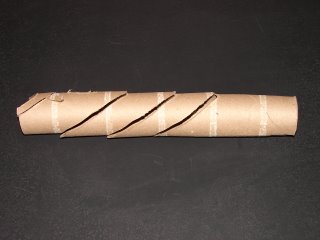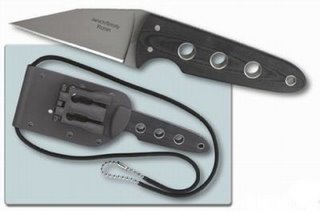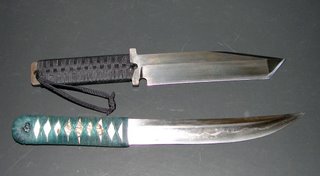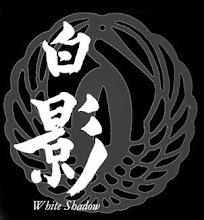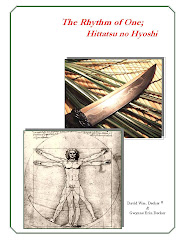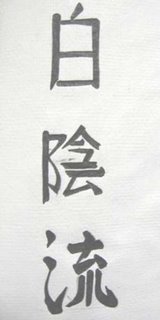 White Shadow DojoClass Make-up & Philosophy:
White Shadow DojoClass Make-up & Philosophy:Our personal philosophy is that we train, if other people come they are welcome to train with us. If they do not come we still have to train. It is really that simple. Many years ago I stopped charging students for lessons. This is my way of repaying a moral debt to my instructors, many who taught me freely. In the White Shadow dojo we use the same method of ranking as a koryu, recognizing only student and mentor grades. Our students train in seitei
[1] sword forms and in knife defense with no expectation of receiving rank. They train purely for the sake of self-improvement. The relationship between mentor and student in our school is different than that found in most schools because of our approach. Sometimes new students who do not understand our philosophy feel they have no obligation to come to class regularly because they have nothing invested and they do not see any tangible reward. To be honest, I do not want a student who comes to class on the basis of rank, promotion, or monetary profit or loss. The students who have stuck with us are excellent technicians, but they have acquired more than technical skills, they have developed a sense of self-worth that a colored belt or a certificate could not have given them.
Our class sizes have always been small, partly because we live in a small town setting, partly because of our philosophy, and partly by choice. Knife defense or knife fighting is not something that I believe should be taught to large faceless classes. This is not like teaching a class on empty-hand fighting, macramé or watercolor painting. I choose to be discriminating about whom I teach and what I teach them. If you choose otherwise you may someday meet one of your own students under adverse conditions and the questions will arise; do you remember him and did you teach him everything you know? Our teaching methods do not use role-playing or acting out scenarios. We feel that training for something that you know is just pretext is a waste of time. There are too many possible scenarios and no real sense of life threatening danger to make them useful.
We focus on hyoshi and gamae, honing the student’s sense of timing and positioning. Obviously, the primary component of any good defense is awareness, being in what is often referred to as condition yellow. Secondary to awareness is your response time, the efficiency of your movements, and an instantaneous and effective counter-attack. So the first, and most important, physical movement is to use the correct angling to shift off-center of the attack. In that same space of time, you should be striking or cutting your opponent, at the same time, not afterwards. This is a core component of our teaching; this is hittatsu no hyoshi, or the rhythm of one.
In fact, our first book The Rhythm of One is about combining defense and offense into one seamless movement. Our methodology is typically more responsive than offensive. Many people talk about reaction times always being slower than actions. That depends totally on the two people. If you don’t believe me, watch how differently people react when a stoplight turns green. Unless a person is deranged and attacks in a blind rage they will have a target in mind. It might be your chest, neck, arm, whatever, but

they consciously make a determination of what and where to attack. Quite often they telegraph this information a fraction of a second before they attack. As the defender your agenda is completely different and you can respond by counter-attacking any part of your opponent that moves or is within reach, without any precognition or forethought. As soon as your attacker locks onto a target you are free to interdict and preempt his attack. Your counter-attack should be aimed at taking control of the center - that imaginary line that runs between two opponents - and taking-out the weapon control system. If your focus is totally on controlling the weapon – in this case the knife - you ignore your attacker’s other weapons. Chushin is the Japanese concept that applies to taking control of the center of an engagement and by doing so denying your opponent his base, disrupting his physical and mental balance.
Our second book will go into greater detail on timing, but I would consider an attacker’s first move to be when he begins to draw his knife, which should be your cue to strike, not when his knife is actually coming toward you. If his knife is already out, then his first move is cocking his weapon arm, and that is when you should attack. So although responsive in nature, I am not advocating that you let your opponent strike or cut you first. (No wonder so many teachers say that you should expect to get cut!) Yes you might get cut but don’t make that a precondition of your training or your response. As Yagyu Munenori said, combat is not about winning, it is about not losing. My strategy is about not getting cut and one of my high priorities is not sacrificing my empty arm by sticking it in the line of attack. This has a lot to do with making a wise choice of stances.
Methodology:Our teaching methods are unabashedly old style and traditional. They rely on performing many repetitions of a technique to build muscle memory until the student is comfortable enough to allow variations in the attacker’s angle and speed. (If you really believe those instructors who say that you can learn a knife art, or any art, during a weekend intensive, then I wish you well.) Once a student has acquired a set of basics to work with, free style sparring - or randori - is allowed at reduced speed and power. When the student has proven their ability to control their techniques they are permitted to work at full speed and power, using either training gear and light contact, or working unencumbered and pulling their techniques. No attacks to the head or throat are permitted for obvious safety reasons. This is a time-tested method. It has been used for hundreds of years in Japan to train some of the world’s most indomitable warriors. Today many students are unwilling to put in the time to perfect even the most basic techniques. They want to learn an entire system in a one-day seminar and unfortunately there are teachers who are willing to meet, teach, and certify them all in one day.
Perhaps the most important difference in our school is what we don’t teach. We don’t teach knife disarms, traditional stances, hollowing out, or grabbing techniques. In contrast to most schools, we teach unassuming stances that do not offer any hint of how, or even if, you intend to defend yourself. Our stances are intended to conceal your skill level or martial arts training. They are completely relaxed, natural and non-confrontational. Being relaxed is very important. If you are not relaxed, then your movements will be tight and slow, and you probably will get cut. Taking a formal stance sends too many signals to your opponent and gives him too much information. Taking a fighting stance may actually trigger an attack, whereas being less confrontational might help diffuse the situation.
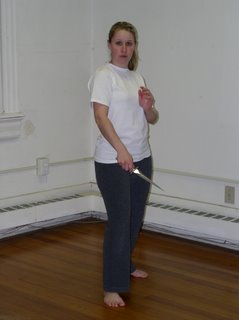
I believe that one of the worst things a teacher can do is place too much emphasis on fighting from a particular stance. It worries the beginning student and becomes a serious distraction. The more unnatural the stance is the worse time the student will have remembering it. All of his other techniques will suffer because of this distraction. I know that it has been said that a proper stance is the foundation on which everything else is built. Attack a well-built house with a bulldozer and see what gives. Now try the bulldozer against a mound of sand or a body of water and see what happens. Students who finally learn the teacher’s signature stance often become rooted in it and end up an easy target for their attacker. Many people have wisely said that the best defense is to not be where the attack takes place. That could mean being in a different part of town or just inches off to the side of a thrust. Either way it requires being mobile not rooted.
Hollowing-out, as a technique, provides your attacker with a wonderful opportunity to make a second attempt to stab or cut you. Hollowing-out will gain you just enough time to think about how much it’s going to hurt when you do get stabbed. When you hollow-out you negate any chance you had of taking the initiative and you have given your attacker the next move. This commonly taught technique is the inevitable result of being too rooted in a stance and being totally unprepared for an attack. A far better option is to simply move off-center, right or left, and strike, cut, or throw your attacker.
We also do not teach grabbing techniques because they do not work! Unless you are very quick, have an iron-man grip, are bigger or stronger than your opponent, and are also incredibly lucky, you are destined to end up with lacerated hands and arms. If you are lacking in any of these elements you will be picking your finger up off the floor. I have had a 250 pound man lock onto my knife hand with both of his hands and I could still cut him. I have seen blood drawn when a man trying to grab a wooden training knife got stabbed in the hand. While you are grabbing the knife hand your attacker still has two legs and one hand free to kick or punch you. Wrestling with an attacker’s knife hand is a last ditch practice that should be avoided at all costs. Remember, to control the knife you should take-out the weapon-bearing arm/hand, the legs that provide mobility, or the control center that directs them, the brain.
Gwynne and I have trained and taught in both karate Gi and street clothes, with and without shoes. The type of clothing worn for training is not that critical if you are teaching sensible techniques. If your techniques include a devastating spinning back-kick then the ladies who go to work in pencil skirts and stiletto heels are in deep trouble. I guess if you want to find out if those advanced techniques will really work, then everyone should wear pencil skirts to the next class. Our classes typically combine a mix of young teens and adults, male and female. Working with a student a foot shorter than me made me appreciate how useless some techniques were, for the shorter person! Training with a slight-built female student weighing 80 pounds less than me made me realize how badly she was going to get pummeled if I didn’t find a better technique for her to use. If that technique was better for her wouldn’t it also be better for a man? Sometimes we get locked into fuzzy logic about this sort of thing and overlook the obvious. Realistically you should not teach some techniques that are specifically for women and others for men. What about teaching big and tall men’s techniques, and small men’s techniques, are they for another day or another seminar?
For the most part, a six-foot, two hundred-pound man does not need much technical skill to assault a one hundred-pound woman, whether he is armed with a knife or not. So the techniques we teach are biased toward the weaker person, the one who is most likely to be the victim anyway, not toward the person more likely to be the aggressor. Body mass or brute strength must not be a part of the technique or the winner and loser are clearly defined before the confrontation even begins. Our techniques rely on avoiding impact or hard-on-hard blocks by choosing the path of least resistance, parrying, deflecting, and transitioning off-line. The techniques must work without the compliance of the “attacker” or they are worse than useless, they are deceptive. There is a very fine line between building a student’s self-confidence and giving them a false sense of security. One time a man asked me to create a simple course for the aged and infirm that they could use to defend themselves. While this is a noble concept I could not in all honesty find any executable techniques that people in this category could expect to use successfully. How do you teach a crippled gazelle to defend itself against a pack of jackals? Unfortunately the laws of natural selection are usually in the predator’s favor. One of the predator’s keenest senses is his ability to find and target the weak and defenseless. For this reason the awareness in your defense must be coupled with an air of confidence and assuredness and not emanating the scent of a victim.
Training Gear:We use a wide variety of training knives in many materials; i.e. wood, rubber, aluminum, steel, and in various sizes and shapes. Hard rubber knives are best for beginners but at a more advanced stage the student is expected to use either an aluminum or steel blunted blade to increase their awareness of being hit. Students who become too comfortable with soft blades can become ambivalent about grazing cuts or light chops. Getting hit with a metal blade helps to restore that crucial sense of realism and blade awareness. For those student’s who attempt a disarm the feel of a metal blade in their hands is more convincing than one made of rubber. It is for these reasons that we do not use foam padded weapons in our training. Live blades - sharp weapons - are used for test cutting and solo drills, and only by the more advanced students. It is not recommended that inexperienced people work with live blades because it is too easy for them to cut themselves while performing even simple flow drills.
Summary:Concerning the question of whether training in a dojo setting is realistic or not, would it make it better if we called it a reality-based-confrontation-center or some other equally silly thing? Dojo is just a word, in our early days we trained barefoot; on asphalt parking lots, the terrazzo floors of our community center and high school hallways, and in grassy back yards. Each of these could have been considered our dojo.
How long does it take to become proficient in unarmed defense against a knife? More importantly, I would ask, how do you know when you are proficient? Certainly performing a knife-disarm in class in not proof positive of your proficiency. The only real proof will be that which no one should hope to gain, surviving an actual knife attack. Let me rephrase the question. How long does it take to become proficient in unarmed defense against a training knife in a class room environment? That depends upon many things including the student’s aptitude and desire. One of the most respected authorities on the subject, William E. Fairbairn, said there is no sure defense against a knife attack. That is a pretty sobering assessment. One important thing I have learned in the past fifty plus years of life is that some systems are better than others, but the instructor’s attitude and his philosophy will have a greater impact on a student’s learning than all of the fancy techniques or systems out there. It bugs me when instructors, who were educated in a traditional style, give recognition to their teachers only for the advertising value and then go on to explain why their new system is better than anything their teacher ever taught. After thousands of years of conflict, a punch is still a punch and a kick is still a kick. Personally I refuse to train under any man or woman who show disrespect to their teacher or his style. Prospective students of the martial arts need to be cognizant of the difference between good qualified instruction and good marketing schemes and I think that this book will help the readers make those educated choices. Thank you for the opportunity to share our philosophy.
Dave Decker II
Instructor
White Shadow Dojo
Tactical Principals of Hittatsu no Hyoshi:1) Assume that anyone approaching you is armed, especially if one or both hands are not clearly visible. Anticipate nothing, expect anything.
2) Never stand facing a possible opponent squarely nor with your weight evenly distributed. You must make sure that you can move in any direction instantly without having to shift your weight.
3) Avoid using hard karate style stances that root you to one spot or give your opponent any indication of your skill level or intentions.
4) Never accept the full energy of your attacker if you can deflect or parry it.
If you must block then use hard on soft and soft against hard.
5) When responding to an attack, taking the outside line is generally safer and improves your chances of escaping, but it is harder to reach, due to having to cross the line of attack. The inside line is tactically better if you have the ability to do serious damage to, and incapacitate your attacker.
6) Your defense and offense must blend into one seamless movement. Once he has initiated a conflict you must not allow your attacker any second opportunity to have another turn.
7) Against a circular attack (hook punch, Roundhouse punch, kick, or stab) enter straight in, and against a straight-line attack use a circular defense.
8) You must take control of the rhythm of the fight very early on if you hope to survive.
9) Always attack the nearest target using the shortest route and then get your weapon hand the heck back out of range. Snap-cuts are the quickest moves and least likely to suffer collateral damage by being intercepted by your opponent’s counter-cuts.
10) NEVER grab for your attacker’s knife or knife hand. The odds of you successfully grabbing and controlling it are miniscule compared to the chances that you will have your hand seriously lacerated and rendered useless. If you want to control the weapon arm do it after you have taken out his weapons control system, the brain.
11) Understand the strategy of purposely leaving a gap in your defense, but be prepared if your attacker doesn’t take the bait.
[1] The Seitei forms are generic sword kata often used for tournaments and suitable for teaching the basics of swordsmanship.

 rious traditions. Some of the schools were large, commercial schools with thirty demonstrators, while others had only four or five members, again exhibiting the variety of choices available for those wishing to study martial arts in the Corning Southern Tier area. Perhaps the most satisfying part of participating in this event was the fact that this demonstration was a cooperative, community event. Instead of pitting the schools against one another, as tournaments do, this event brought martial arts practitioners together in a spirit of sharing and learning. It was unfortunate that public attendance was small, however this was the first event of its kind in the area and the Sister Cities Kakegawa Program hopes to make this an annual event in the future.
rious traditions. Some of the schools were large, commercial schools with thirty demonstrators, while others had only four or five members, again exhibiting the variety of choices available for those wishing to study martial arts in the Corning Southern Tier area. Perhaps the most satisfying part of participating in this event was the fact that this demonstration was a cooperative, community event. Instead of pitting the schools against one another, as tournaments do, this event brought martial arts practitioners together in a spirit of sharing and learning. It was unfortunate that public attendance was small, however this was the first event of its kind in the area and the Sister Cities Kakegawa Program hopes to make this an annual event in the future. Four members from our school demonstrated Iaido, the art of drawing and cutting with the sword. We offer a basic Japanese swordsmanship class at our dojo which includes a thorough study of the sword and its parts, and the history, philosophy, and use of the sword. Our members demonstrated techniques from three schools of swordsmanship and explained briefly about the use, history, and development of the Japanese sword. Many of the martial arts schools who attended offer basic instruction in some style of swordsmanship for their black belt practitioners. However, in this situation the sword is typically taught along with a variety of other weapons, and the techniques lose their subtlety and refinement, and are often misunderstood. In many schools it seems as if the sword is viewed as the next step when the Karate student progresses to black belt. This is a fine notion if the student is willing to put in the serious time and effort to studying this weapon (or any other weapon for that matter). I think that our members offered an interesting demonstration and perspective on the study of swordsmanship and reminded those in attendance that the study of the sword is in itself a tradition and lifelong pursuit, just like studying Karate or any other open-hand art.
Four members from our school demonstrated Iaido, the art of drawing and cutting with the sword. We offer a basic Japanese swordsmanship class at our dojo which includes a thorough study of the sword and its parts, and the history, philosophy, and use of the sword. Our members demonstrated techniques from three schools of swordsmanship and explained briefly about the use, history, and development of the Japanese sword. Many of the martial arts schools who attended offer basic instruction in some style of swordsmanship for their black belt practitioners. However, in this situation the sword is typically taught along with a variety of other weapons, and the techniques lose their subtlety and refinement, and are often misunderstood. In many schools it seems as if the sword is viewed as the next step when the Karate student progresses to black belt. This is a fine notion if the student is willing to put in the serious time and effort to studying this weapon (or any other weapon for that matter). I think that our members offered an interesting demonstration and perspective on the study of swordsmanship and reminded those in attendance that the study of the sword is in itself a tradition and lifelong pursuit, just like studying Karate or any other open-hand art.  This event fostered mutual appreciation and respect among the attending martial arts schools, instructors, and students and offered a realistic perspective of the martial arts to the public. The instructors all agreed that this was a great way of reminding themselves and their students just how much there is to learn and how important it is to work together to promote the values and benefits of the martial arts. In a world where competition can be cut-throat and the martial arts have become big business, it was refreshing to see that some practitioners still remember and embrace the values which were passed down to them by their sensei and forbearers.
This event fostered mutual appreciation and respect among the attending martial arts schools, instructors, and students and offered a realistic perspective of the martial arts to the public. The instructors all agreed that this was a great way of reminding themselves and their students just how much there is to learn and how important it is to work together to promote the values and benefits of the martial arts. In a world where competition can be cut-throat and the martial arts have become big business, it was refreshing to see that some practitioners still remember and embrace the values which were passed down to them by their sensei and forbearers.